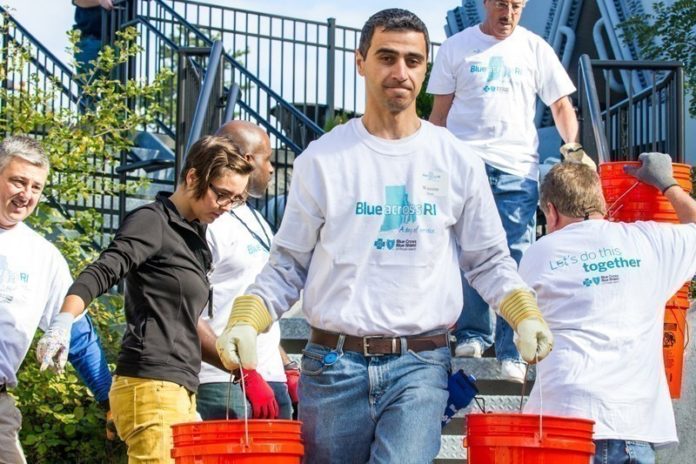
Byron Allgood, a shipping coordinator at Collette for 24 years, volunteers up to 20 hours a month mentoring an 11-year-old boy at the Pawtucket Boys & Girls Club, and for four of those hours he is paid by Collette as if he were working.
“It’s great,” Allgood said of the mentoring he does and his company’s support of it. “I’m such a better person because of him, he’s such a bright kid who was kind of shy until he got into the program. It’s very beneficial for both of us. The idea they give us the time off to do that – it’s not just me; a lot of people are doing it – it’s a wonderful thing. I’m grateful for the opportunity.”
Allgood’s paid time off is part of a Collette program allowing four paid hours of community service a month to employees as long as the volunteer work is in keeping with the mission of the company’s Collette Cares philanthropy program and focuses on basic needs like homelessness or hunger or youth initiatives, said Lynne Kelly, Collette’s community relations manager.
Collette is just one of a variety of companies in Rhode Island and around the country offering increasingly popular paid release-time programs to employees who volunteer in the community.
According to the CECP (previously known as the Committee Encouraging Corporate Philanthropy), a coalition of CEOs who consider societal improvement an essential measure of business performance, the percentage of companies offering paid release-time volunteer programs increased from 53 percent in 2007 to 70 percent in 2012, the most recent year data was available. The information is from CECP’s study, “Giving In Numbers: 2013 Edition.”
Margaret Coady, the CECP’s executive director, said the millennial generation is actively seeking this perk, while employers are finding it supports retention. Also known as Generation Y, millenials are typically considered those born between 1980 and 2000.
While Collette did not participate in the survey upon which the CECP study was based, other Rhode Island companies who did included Hasbro Inc.
Seventy-five percent of Pawtucket-based Hasbro’s more than 3,100 international employees volunteered with children in 2013 using up to four hours of paid time off, said Karen Davis, Hasbro’s vice president of community relations. The participation rate is increasing from year to year, she said, though she couldn’t provide specific details.
“A lot of people end up volunteering on their own time, but it ends up creating a culture of giving back to the communities where we live, and that’s an important part of being an employee with Hasbro,” Davis said, explaining why the company invests in volunteerism.
Other Rhode Island companies who were not part of the survey but do provide paid time off for volunteerism include GTECH S.p.A. and Blue Cross & Blue Shield of Rhode Island.
With 550 employees worldwide, Kelly said Collette’s participation in volunteering using paid time off has trended up steadily, from 343 employees donating 1,600 hours in 2011 to 476 employees in 2013 donating 2,263 hours of service.
“We’re going real strong on numbers for 2014,” she added. “They’re way up already.”
Blue Cross launched a paid time off program for volunteers in 2008 and has seen growth, though participation has leveled off in the last few years to about 35 percent of the company’s 850 employees, said Carolyn Belisle, director of community investment.
At GTECH in Providence, where 1,000 of the international company’s 8,600 employees are located, about 100 employees participated in the Day Off for Volunteerism, which gives employees a paid eight-hour day to volunteer at a nonprofit of their choosing.
“Participation is steady,” said Kim Fraser, a GTECH public relations representative. “People love the idea; it’s always finding time to do it” that’s a challenge.
Bruce Parkes of Cranston, a GTECH consulting hardware engineer, and Lindsay Pare of North Kingstown, a GTECH financial analyst, both indicated they would use even more paid time off to volunteer if it were available. Pare recently used her time off to help coordinate a golf tournament for Mothers Against Drunk Driving Rhode Island.
According to Blue Cross, all types of volunteer work employees did, including paid time off, totaled about 6,300 volunteer hours, valued at $135,000 – a reflection of about 10 percent of total giving, Belisle said.
While comparable data was not available at other companies, the CECP’s Coady said, the typical company in its study sample puts total giving at just under $20 million a year.
“Volunteerism even though it’s paid time off is actually reported separately,” she said. “That doesn’t even include the value of volunteerism. So for that company, the value of the volunteer hours comes in at $2.2 million, or about 10 percent.”
Paying for some of an employee’s volunteered time “helps build community relations in a very authentic way,” Coady said. •











